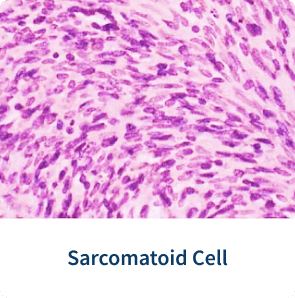Sarcomatoid Mesothelioma
Sarcomatoid mesothelioma is one of three cell types seen in 98% of pleural patients. This type accounts for 10% to 20% of all cases. The median overall survival for sarcomatoid patients is 8.6 months. Treating sarcomatoid mesothelioma can be challenging. Early diagnosis is vital.
Written byKaren Selby, RN•Edited ByWalter Pacheco•Medically Reviewed ByDr. Jacques Fontaine
Asbestos.com is the nation’smost trustedmesothelioma resource
The Mesothelioma Center at Asbestos.com has provided patients and their loved ones the most updated and reliable information on mesothelioma and asbestos exposure since 2006.
Our team of Patient Advocates includes a medical doctor, a registered nurse, health services administrators, veterans, VA-accredited Claims Agents, an oncology patient navigator and hospice care expert. Their combined expertise means we help any mesothelioma patient or loved one through every step of their cancer journey.
More than 30 contributors, including mesothelioma doctors, survivors, health care professionals and other experts, have peer-reviewed our website and written unique research-driven articles to ensure you get the highest-quality medical and health information.
About The Mesothelioma Center at Asbestos.com
- Assisting mesothelioma patients and their loved ones since 2006.
- Helps more than 50% of mesothelioma patients diagnosed annually in the U.S.
- A+ rating from the Better Business Bureau.
- 5-star reviewed mesothelioma and support organization.
Testimonials
My family has only the highest compliment for the assistance and support that we received from The Mesothelioma Center. This is a staff of compassionate and knowledgeable individuals who respect what your family is experiencing and who go the extra mile to make an unfortunate diagnosis less stressful. Information and assistance were provided by The Mesothelioma Center at no cost to our family.LashawnMesothelioma patient’s daughter
How to Cite Asbestos.com’s Article
APA
Selby, K. (2023, September 25).Sarcomatoid Mesothelioma.Asbestos.com. Retrieved October 11, 2023, from //www.magnakarsa.com/mesothelioma/malignant-sarcomatoid/
MLA
Selby, Karen. "Sarcomatoid Mesothelioma."Asbestos.com, 25 Sep 2023, //www.magnakarsa.com/mesothelioma/malignant-sarcomatoid/.
Chicago
Selby, Karen. "Sarcomatoid Mesothelioma." Asbestos.com. Last modified September 25, 2023. //www.magnakarsa.com/mesothelioma/malignant-sarcomatoid/.
What Is Sarcomatoid Mesothelioma?
Sarcomatoidmesotheliomais a rare type of cancer caused by asbestos. This cancer can affect the lungs, heart, abdomen or testes. Sarcomatoid refers to the tumor cell type. These cells make up most of the tumors for this类型的间皮瘤.
- About 2% ofperitoneal mesotheliomapatients have the sarcomatoid type.
- Doctors diagnose 300 to 600 new patients with this cell type yearly.
- Sarcomatoid cells are present inpleural mesotheliomacancer 98% of the time.
- This type of mesothelioma accounts for 10% to 20% of all cases.
Sarcomatoid cells grow in connective tissues, such as bones, nerves and tendons.The sarcomatoid type is the rarest of the three primary cell types. For comparison, about 60% of patients have theepithelialtype, and 20% have thebiphasictype.
Tumors of the sarcomatoid cell type are more likely to spread to new areas. They’re also more resistant to treatment.
“Sarcomatoid mesothelioma is a rare subtype in contrast to epithelial,” saidDr. Andrea Wolfin an exclusive interview with The Mesothelioma Center. “Sarcomatoid tends to be a little more locally progressive.”

What Causes Sarcomatoid Mesothelioma?
Asbestos is the primarycauseof sarcomatoid mesothelioma. Breathing or swallowing asbestos traps fibers in the body. Over time, irritation and inflammation lead to mesothelioma cancer.间皮瘤风险的事实orsinclude exposure on the job or from the environment.

Symptoms take a long time to appear, approximately 20 to 60 years after asbestos exposure. They often resemble those of more common illnesses. If you have a history of asbestos exposure, speak with your doctor about early screening. More treatment options may be available to you.
Sarcomatoid Mesothelioma Symptoms
The most common symptoms of sarcomatoid mesothelioma are shortness of breath, chest pain and coughing. Sarcomatoid cells are most often found in pleural disease that develops in the lining of the lungs. Severe symptoms include difficulty breathing and persistent cough. Sarcomatoidmesothelioma symptomscan take between 20 and 60 years to appear.
- Anemia (low iron)
- Chest pain or abdominal fullness
- Coughing up blood
- Fatigue and extreme tiredness
- Lack of appetite, anorexia and nausea
- Low blood oxygen levels
- Persistent cough
- Prolonged hoarseness
- Shortness of breath
- Weight loss and weakness
Most symptoms depend on tumor location. Patients with sarcomatoid peritoneal cancer will have abdominal symptoms. They may experience bowel problems, abdominal pain and swelling. If you have any symptoms or a history of asbestos exposure, speak with a specialist as soon as possible.
How Is Sarcomatoid Mesothelioma Diagnosed?
Doctors use imaging and biopsies to confirm a sarcomatoidmesothelioma diagnosis. Imaging studies such as X-rays, CT scans and MRIs reveal abnormalities in the chest. Your doctor or a surgeon will collect a tissue sample for the biopsy. Another doctor reviews the cells under a microscope and creates a pathology report.
只有一个biopsycan show specific details such ascell type. Pathology stains are chemical laboratory tests that make cellular features stand out under a microscope. Sarcomatoid cells are long, narrow and shaped like spindles. Epithelial cells are round and rectangular, making them easier to treat.
The shape of sarcomatoid cells causes them to break apart more often. As they do, the cells become more challenging to remove and can travel to new areas and metastasize.
Understanding Your Pathology Report
Your pathology report describes the tumor cell type, biomarkers and cancer stage. Your doctor uses the findings to complete your diagnosis and can also use them along withblood teststo track treatment. Ask your doctor about your report so you can make informed treatment decisions.
“Most patients don’t know their cell type when I initially speak with them,” said Patient AdvocateDr. Snehal Smartof The Mesothelioma Center. “I help them review their pathology report and explain what sarcomatoid cell types are and what this means for them and their doctor to determine the best treatment plan for that patient.”
Immunohistochemical markers, or biomarkers, can indicate how to treat your cancer. These markers are like flags telling your doctor which drugs work best. For example, if sarcomatoid cells in your tumor express high levels ofPD-L1, it will appear when a pathologist stains them. Checkpoint inhibitor drugs such as Opdivo and Yervoy may be the most effective in this case.
Rare Sarcomatoid Cell Types
Rare sarcomatoid mesothelioma cell subtypes can complicate your diagnosis. These types come in three categories. Some may provide a better prognosis. Others can point to a higher chance of metastasis.
- Desmoplastic Mesothelioma.This sarcomatoid subtype is one of the most difficult to diagnose. With this cell type, doctors may be unable to track if your tumor is growing.
- Lymphohistiocytoid Mesothelioma.These tumors contain inflammatory and immune cells. This can translate to more symptoms but also a better life expectancy.
- Transitional Mesothelioma.This type grows and spreads like other subtypes. It consists of large, spindle-shaped cells that make the disease easier to diagnose.
Sarcomatoid mesothelioma subtypes are rare. They most often develop in the pleura. Ask your physician whether there are any abnormalities in your pathology report. They can offer more information on your prognosis.
What Is the Survival Rate of Sarcomatoid Mesothelioma?
The median overallsurvivalfor sarcomatoid mesothelioma is 8.6 months. In a 2021 clinical research study, patients with sarcomatoid mesothelioma who received immunotherapy had a median overall survival of 15 months. The median overall survival was 10.7 months for those who received chemotherapy.
Each patient’sprognosisdiffers based on health, tumor location andmetastasis. Doctors use past data to make prognosis estimates. Patients with pleural sarcomatoid mesothelioma survive about five months. Those with the peritoneal form have alife expectancyof about 10 to 11 months after diagnosis. Women with the sarcomatoid type tend to live longer than men.
The most impressive advancement for checkpoint blockade has been the demonstration that for people with sarcomatoid and biphasic mesothelioma, we can double survival with the combination of ipilimumab and nivolumabDr. Anna NowakResearcher at the Institute for Respiratory Health in Western Australia
Sarcomatoid cells are resistant to treatment because of their fibrous nature. Your outlook will improve as more treatment options become available. New therapies through clinical trials may work better for some patients.
“The most impressive advancement for checkpoint blockade has been the demonstration that for people with sarcomatoid and biphasic mesothelioma, we can double survival with the combination of ipilimumab and nivolumab,” Dr. Anna Nowak, a researcher at the Institute for Respiratory Health in Western Australia, told The Mesothelioma Center.
Treatment Options for Sarcomatoid Mesothelioma
Sarcomatoid间皮瘤治疗方案include immunotherapy, chemotherapy, targeted therapy and radiation therapy. These options differ for each patient based on cancer stage, tumor extent and overall health. Seeking amesothelioma specialistat atop cancer centeris the best way to learn all your options.
- Chemotherapy.Patients with sarcomatoid mesothelioma who receive pemetrexed (Alimta) plus cisplatin or carboplatinchemotherapyhave a median survival of 15 months.
- Immunotherapy.Theimmunotherapydrugs nivolumab and ipilimumab can improve patient survival by four months compared to chemotherapy.
- Palliative Care.Less invasive chemotherapy and surgery can ease symptoms, slow tumor growth and improve breathing quality throughpalliative care.
- Radiation Therapy.Radiationis often used alongside other therapies and has increased the 2-year life expectancy by 30% for some patients.
- Targeted Therapy.Targeted therapiesAZD8186等显示效果的年代ome cancers inclinical trials.
- Tumor Treating Fields.Tumor Treating Fieldstherapy is noninvasive and uses adhesive pads and electrical pulses to disrupt tumor growth.
“Sarcomatoid mesothelioma is a little less responsive to chemotherapy,” mesothelioma specialistDr. Andrea WolfofMount Sinai Hospitaltold The Mesothelioma Center at Asbestos.com. “But from what we see from more recent data, it may be more responsive to immunotherapy. And we have additional treatment options for those patients.”
Common Questions About Sarcomatoid Mesothelioma
- Where can I get treatment for sarcomatoid cell mesothelioma?
-
You can get sarcomatoid mesothelioma treatment from a top treatment center specialist. This cell type is more challenging to treat and needs a team of experts. Pleural cancer requires the best thoracic surgeons and oncologists with experience. Peritoneal patients should seek a top doctor with years of experience in asbestos cancers and abdominal cancer treatment.
- Can sarcomatoid mesothelioma be prevented?
-
You can prevent sarcomatoid mesothelioma by being aware of asbestos exposure risks. Exposure tends to happen at job sites or from damaged materials containing asbestos. Find out whether you have asbestos-containing materials in your home. If you do, take steps to prevent exposure, such as hiring an abatement professional.
- Is sarcomatoid mesothelioma curable?
-
Like other forms of this cancer, sarcomatoid mesothelioma is not curable. Clinical research trials are testing the latest methods to improve the safety and effectiveness of new drugs. Talk to your doctor about the best options for you. Some treatments, such as those in clinical trials, may extend your life for several years.
- Is there any ongoing research on sarcomatoid mesothelioma?
-
是的,研究人员正致力于小说海藻糖酶的方法t sarcomatoid mesothelioma. Many patients have found success with new immunotherapy drugs. You may be eligible to join a clinical trial and receive the latest medication that targets sarcomatoid cells. Ask your mesothelioma specialist which treatments are right for you.
- Is sarcomatoid mesothelioma different than sarcomatoid carcinoma?
-
Yes, sarcomatoid mesothelioma and carcinoma are two different types of cancer with unique origins and characteristics. Sarcomatoid mesothelioma is a subtype of malignant mesothelioma. This cancer arises from the mesothelial cells that line the lungs, abdomen or heart. It involves the presence of spindle-shaped or elongated tumor cells. These cells resemble those in sarcoma, a cancer that arises from connective tissue.
Sarcomatoid carcinoma is a subtype of carcinoma. This cancer comes from epithelial cells that line various organs and tissues. It can occur in several organs, including the lungs, liver and pancreas. Treatment is often different between the two types based on location and stage.










